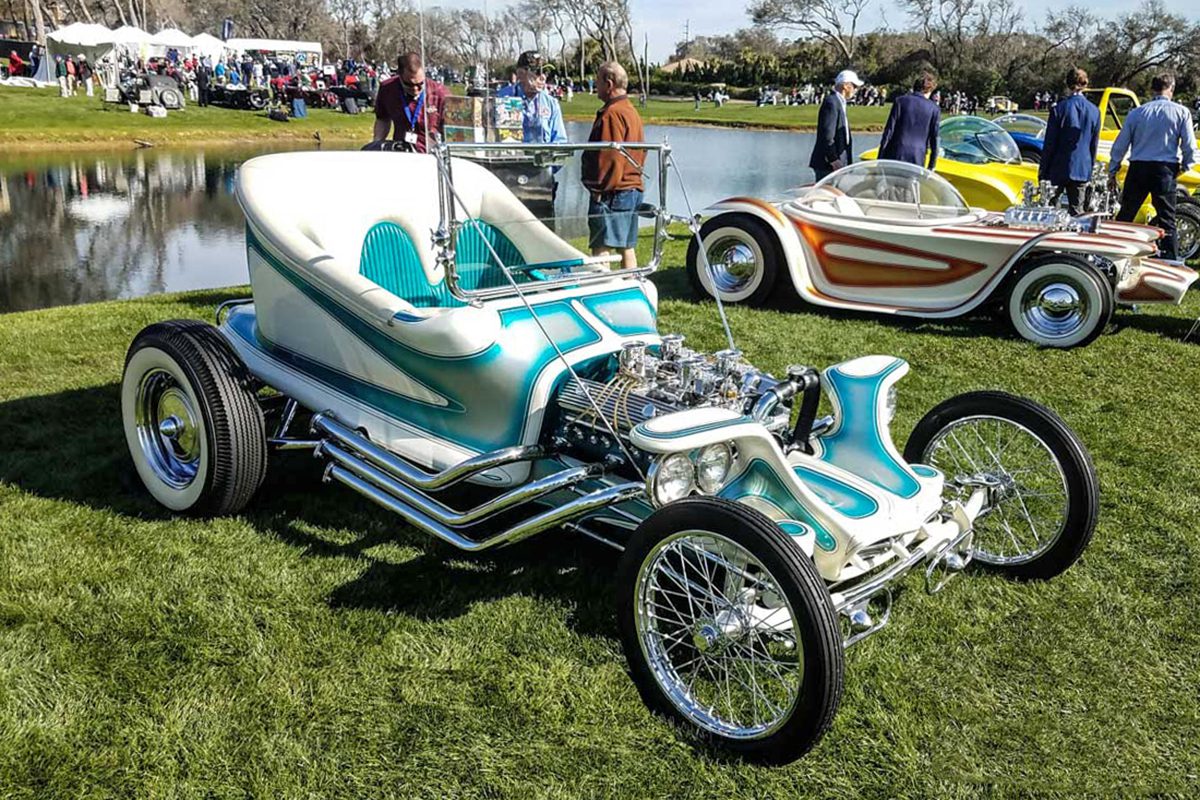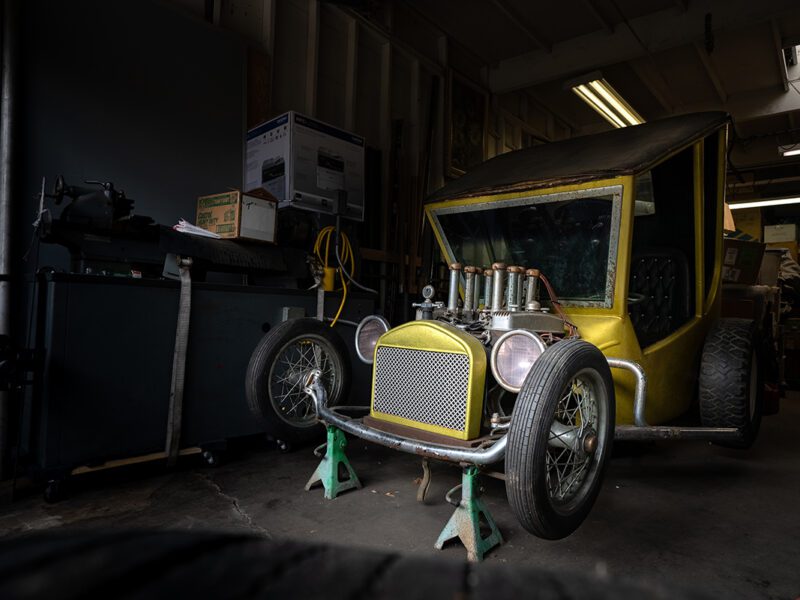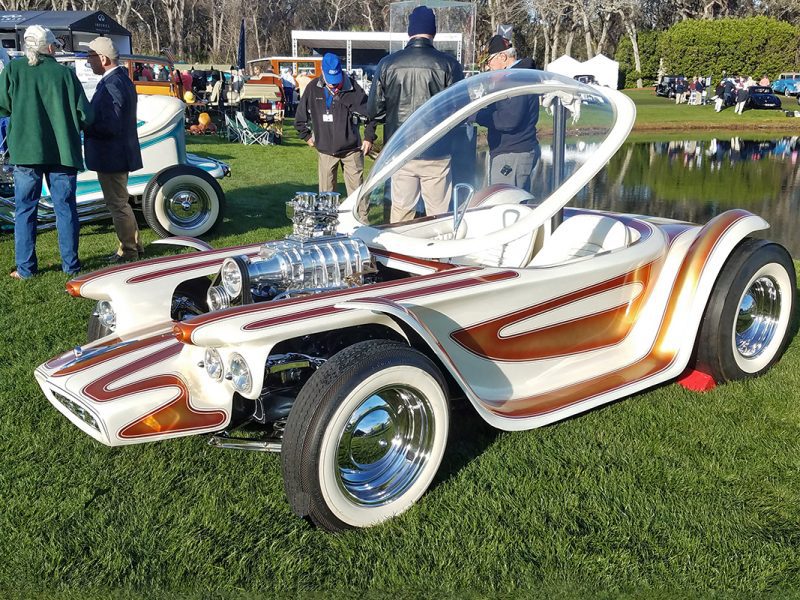The Outlaw – Ed Roth’s Radical Custom Roadster
Two months ago, we featured the late Andy Brizio’s wild T-Bucket that won America’s Most Beautiful Roadster in 1970. The article also mentioned two other notable T-buckets, those crafted by actor/racer Tommy Ivo and hot rodding’s premier funny man, Norm Grabowski.
At the same time, wild man Ed “Big Daddy” Roth was creating his own roadster, one that featured the outlines of a T-Bucket but was adorned with so many appendages and stylish accoutrements that it made Tommy and Norm’s versions nearly unrecognizable.
For readers unfamiliar with Big Daddy, here’s a quick primer. Roth was born in 1932 in that hub of wealth and privilege, Beverly Hills, but grew up in the humble Los Angeles suburb of Bell. He studied auto shop and art in school and added technical drafting in the Air Force.
By the mid-1950s, Roth earned a living pinstriping and custom painting. He also excelled on another other canvas – hand-painted T-shirts. This artistry led to the creation that fueled his fame, the legendary Rat Fink character, a loathsome yet endearingly menacing rodent. Mr. Fink is still popular today, seven decades later.
During this period, Roth began work on The Outlaw, which he originally dubbed Excaliber (misspelled by Roth, perhaps on purpose). Roth started with a basic ’29 Ford Model A frame fit with a ’25 Model T crossmember. He slipped a boneyard ’50 Caddy V8 between the frame rails. That was the easy stuff. Having been smitten by a newfangled material called fiberglass, Roth thought the new material’s moldable nature could be the foundation for something special.
He first tried to make the body plug out of wood but that proved too complicated. Undeterred, he shaped the body form out of casting plaster. When the form was to Roth’s liking, he applied the fiberglass.
But it wasn’t quite that simple. Fiberglass was so new, Ed was flying blind, trial-and-error over and over until it met his approval. Once the resin cured, he knocked out the plaster from the backside creating a female mold – four-pieces held together with school lunchbox latches!
New to car building, Roth’s toolbox was more box than tools. When he needed something welded, he mocked up the pieces using baling wire and then trailered the car to a local trailer shop for final welding. Roth was big on chroming, too. The entire frame, rear axle, drive shaft, and a ’39 Ford transmission were chrome plated.
The Caddy powerplant was rebuilt and adorned with a quartet of Stromberg 97s on a Cragar manifold. Cal Custom finned valve covers, a chromed oil pan, and sweeping headers added to the bling. Up front, Roth hung a front axle and spindles from a ’37 Ford riding on cut-down ’58 Chevrolet coil springs.
The body shape nearly defies description. It hints at T-bucketness yet was transformed by a host of Roth-inspired madcap touches – a swoopy rear section that seamlessly absorbs ’58 Chevrolet Bel Air taillights; a custom grille shell that sprouts “wings” that shaded a tetrad of Rambler sealed beams; blue tinted safety glass that was wedged into a 1922 windshield frame.
The interior featured a ’58 Chevrolet Impala steering wheel, Stewart-Warner gauges, and a shift lever made from a Revolutionary war sword donated by his mother-in-law. The swashbuckling gear shift inspired the early Excaliber moniker. Renowned trimmer Eddie Martinez finished it off in white naugahyde tuck ’n roll. The exterior was masterful paint job by a master painter – Goodguys Gazette Legend Larry Watson – consisting of fogged candy-green panels over a stunning pearl white lacquer.
The Outlaw debuted at the Car Club Day and Autocade Show at Disneyland in 1959, to a wide-eyed and appreciative audience. Its popularity grew quickly. By 1960 Roth was selling 8×10 prints in Car Craft magazine, and it won so many show trophies, Roth joked it wasn’t fair. Although he did miss out at the 1960 Oakland Roadster show, disqualified for using nylon lock nuts rather than castle nuts with cotter pins.
Famed rocketed further when Revell issued a model kit of The Outlaw. No telling how many were sold, but who among us didn’t spend time as a kid with plastic cement smudging our fingers while we assembled Roth’s radical creation.
Like many legendary hot rods, The Outlaw bounced from multiple owners, the first being custom car show mogul Bob Larivee, who bought it for $3,200. Today, it is on display at the National Corvette Museum in Bowling Green, Kentucky. A spot-on recreation is preserved at the Speedway Motors Museum of American Speed in Lincoln, Nebraska.
The Outlaw was Roth’s first custom car in a line of wild show cars that would follow – the Beatnik Bandit, Mysterion, and Orbitron, to name but a few. And you can see the through line from The Outlaw through all his creations. Famed novelist and writer Tom Wolfe once called Roth a “surrealist,” not unlike Spanish painter Salvador Dali. One look at The Outlaw and few would disagree.
Considered an artistic savant by hot rodders and art critics alike, perhaps Roth’s secret was drawing on his youthful enthusiasm. As he told the Los Angeles Times in 1973, “I know what I am. I’m a weirdo. I never grew up.” And The Outlaw proves the point.





